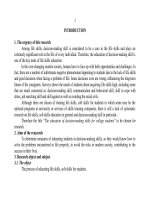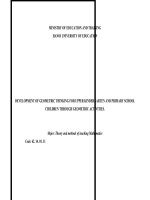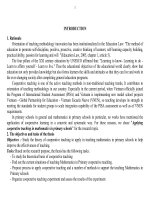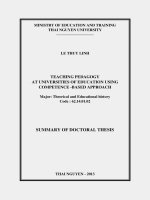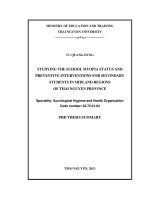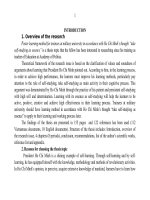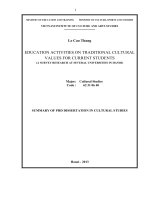thiết kế tình huống dạy học hình học ở trường trung học phổ thông theo hướng giúp học sinh kiến tạo tri thức bản tóm tắt tiếng anh
Bạn đang xem bản rút gọn của tài liệu. Xem và tải ngay bản đầy đủ của tài liệu tại đây (615.65 KB, 28 trang )
MINISTRY OF EDUCATION AND TRAINING
HANOI UNIVERSITY OF EDUCATION
NGUYEN TIEN TRUNG
DESIGNING GEOMETRY TEACHING SITUATIONS
AT HIGH SCHOOL FOR HELPING STUDENTS
CONSTRUCT NEW KNOWLEDGE
Major: Theory and methods of teaching Mathematics
Code: 62. 14. 01. 11
SUMMARY OF PEDAGOGICS DOCTORAL THESIS
HA NOI – 2013
2
Science instructor: Prof, Dr. BUI VAN NGHI
Judge 1: Prof, Dr. of Sci. NGUYEN BA KIM, Dr.
Judge 2: ASS.P Assoc. Prof, Dr. NGO HUU DUNG Vu Duong
Judge 3: Dr. Ngu Assoc. Prof, Dr. TRAN VUI n Van Thuan
Thesis will be defended in front of Council at University:
Hanoi University of Education, date:…………………….
Thesis can be seen at National Library and Library of Hanoi National
University of Education.
3
REFERENCES
1. Books
1
Bui Van Nghi - Nguyen Tien Trung (2009), Teaching based on standards of knowledge,
skills of mathematics 12
th
grade, University of Education Publishing house.
2
Bui Van Nghi - Tran Trung - Nguyen Tien Trung (2010), Teaching based on
standards of knowledge, skills of mathematics 11
th
grade, University of
Education Publishing house.
2. Journals
1
Nguyen Tien Trung (2009), Recommendation engine in teaching the cosine
theorem in the triangle (Geometry for 10
th
grade), Journal of Educational Science,
No 206, p. 35-37.
2
Nguyen Tien Trung (2011), Adidactic situation and mathematics teaching situation,
National Scientific conference of young teacher in pedagogical universities, the first
2011, Hanoi National Univesity of Education, pp. 588-593.
3
Nguyen Tien Trung (2011), Designing teaching situation: Developing formula to
calculate distance from a point to a line (Geometry for 10
th
grade), Journal of
Educational Science, No 275, pp. 34-35.
4
Bui Van Nghi - Nguyen Tien Trung (2012), Designing a teaching situation: the cross
product of two vectors concept, Journal of Science of Hnue, Vol. 57, No. 1, pp. 3-7.
5
Bui Van Nghi - Nguyen Tien Trung (2012), Designing teaching situation: Defining
plane section of puramid (original line of intersection method), Journal of
Educational Science, No 290, pp. 49-51.
6
Bui Van Nghi - Nguyen Tien Trung (2013), Designing teaching situation: Defining
plane section of puramid by the way of using the radial projection (the
alignment method) (Geometry 11th grade, Chapter 2), Journal of Educational
Science, No 301, pp. 45-47.
7
Bui Van Nghi - Nguyen Tien Trung (2013), Some opinions on design the situation
of mathematic teaching in high school towards improving the positive student
perceptions, Journal of Educational Science, No 312, pp. 45-47; 50.
8
Bui Van Nghi-Nguyen Tien Trung (2013), Designing a teaching situation:
Developing formula to caculate the distance from a point to a plane in space
(Geometry for 12
th
grade, Chapter 3, Lesson 2), Journal of Science of Hnue,
Interdisciplinary Science, Vol. 58, No. 5, pp. 47-52.
3. Scientitic project
1
Nguyen Tien Trung, Designing some geometry teaching situations in high school,
No SPHN-10- 591NCS, Grade school Science project of Science and Technology,
Hanoi National Univesity of Education, acceptance on 7/12/2012.
4
1
INTRODUCTION
1.1. REASONS FOR CHOOSING TOPIC OF THE THESIS
* Approach in reasearch problems from published thesis. The thesis
builds upon success of physiology, pedagogy and teaching methods applied by
Vietnamese lecturers in 1960s of the 20
th
century. There have been some well-
known theories such as: theory of cognitive development by J.Piaget, theory of
pschological activity; cultural historical theory of psychological development of
high level psychology funtions by L.X. Vygotsky, theory of didactical situation by
Guy Brousseau , …At that time, Vietnamese education scholars who had been
experienced in teaching match made some innovations in teaching method. One
of the most focused issues were how the theory of teaching method could be
adapted to realities of teaching in Vietnam .
Conducting research on view on action based teaching, professor Nguyen
Ba Kim was interested in action based learning , [50], [49], associate professor
Trinh Thanh Hai had his opinion on how to apply action learning to technology
training sessions at high school (2009)[35], doctor Nguyen Huu Hau (2012)
focused on finding more actions, training students and facilitating their learning
[40]. Professor Nguyen Huu Chau who had dedicated himself to give insights
into effective action learning emphasized the importance of enhancing
students’motivated cognitive abilities [11]. Professor Dao Tam who had taken
interest in classification of learning activities conducted research on
constructivist teaching in action, “hoạt động biến đổi đối tượng” and cognitive
activities.… [83], [85], [86], [88] .
With a view to study on theories of teaching and pschological theories of
Maths teaching, there have been well- know researches such as constructivist
approach in learning and teaching Maths conducted by professor Nguyen Huu
Chau (1996) [12], application of constructivist view on geometry teaching at high
school by doctor Cao Thi Ha (in teaching solid geometry) [13], [33]. Theory of
didactical situation had been main concern of many education scholars who
employed it in teaching maths. There have been some few more findings of
application of theory of didactical situation to teaching for example researches
done by Do Thi Chau (2008) [7] by Vu Dinh Phuong (2008) [72]. From the best
of my knowledge, in order to make theory of didactical situation become practical
applications in Vietnam, a number of considerable adaptation would be required.
2
There has been a growing trend of application of teaching methods to math
teaching. The most common issues could be raised[103], interactive teaching
method or collaborative teaching [23], [59], [60], ….
* Research demand characteristics: The upcoming orientation of
education innovations in the 21
st
century includes: renewed teaching method,
surmounting single impartion of information, improved critical thinking skills
and applying advanced education method to teaching, enhanced self-study
Geometry which plays the most part in high school level of Maths,
provides students with the basis of plane geometry and solid geometry
(including knowledge of the method of coordinates in the plane and the method
of coordinates in space). Moreover, geometry enables teacher to develop
student’s logical thinking. Consisting largely of abstract knowledge, geometry
requires teacher to take an action based teaching which aims at inspires
student’s positive thinking and enriches the lessons.
After years of investigating issues, we have found that a lot of attempts
have been made to apply active perspective as well as constructivism and
theory of didactical situations to mathematic teaching at high school. However,
very few researches on teaching situations especially geometry teaching
situations which we are searching for could be found.
1.2. RESEARCH PROJECT
From the reasons above, we have chosen project “Designing geometry
teaching situations at high school for helping students construct new
knowledge”.
1.3. SCIENTIFIC HYPOTHESIS
If applying the active perspective, idea of constructivism and theory of
situations (the theory of tidactical situations in mathematics), we can design
teaching situations in geometry at high school in which student can construct
their new knowledge.
1.4. RESEARCH OBJECTIVE AND RESPONSIBILITY
Research objective: Designing some specific example of geometry
teaching situations at high school which inspire students and enable their
constructivist learning. THDH, teaching plan and designs of THDH based on
constructivist learning would be recommended.
Responsibilities:
3
+) Investigation of maths teaching and learning and practical teaching
+) Proving theoretical frame of math teaching situations in general and
geometry teaching situations in particular at high school.
+) Clarifying the viewpoint and design of geometry teaching situations
based on contructivist learning at high school
+) Recommending plan to design geometry teaching situations at high school.
+) Designing and experimenting with some examples of geometry teaching
situations, completing some geometry teaching situations at high school based
on clarified viewpoints.
1.5. RESEARCH OBJECTIVE
Geometry teaching situations at high school and students’s constructivist learning.
1.6. RESEARCH SCALE
Content, geometry program and common geometry teaching situations at
high school.
1.7. SCIENTIFIC VALUES AND FEASIBILITY
The thesis have recommeded several geometry teaching situations for helping
students construct new knowlegde at high school. The mentioned teaching
situations that were practically designed and experimented would be possible for
mathematic teachers to apply at high schools.
In the thesis, author has showed his opinion on a teaching situations, plan and
design of geometry teaching situations for helping students construct new
knowlegde at high school. Thus, the thesis highly supports teachers who are
devoted to study and design geometry teaching situations particularly and
mathematic teaching situations generally in the hope of producing higher teaching
quality at high school.
1.8. RESEARCH OUTLINE
The thesis consits of 3 parts dividing up into 5 chapters (excluding index of
abreviations, photos, figures, reference and appendix.…):
INTRODUCTION
RESEARCH OVERVIEW
RESULTS
CHAPTER 1: THE FIRST RESEARCH RESULT
4
CHAPTER 2. THE SECOND RESEARCH RESULT
CHAPTER 3: THE THIRD RESEARCH RESULT
CHAPTER 4: THE FOURTH RESEARCH RESULT
CHAPTER 5: THE FIFTH RESEARCH RESULT
CONCLUSION AND RECOMMENDATION
RESEARCH OVERVIEW
2.1. DEFINITION OF TERMS
2.1.1. Learning actions
2.1.2. Teaching actions
2.1.3. Situations
2.1.4. Teaching situation
Teaching situation is a circumstance in which teacher gives lesson and
student learns in a session or some sessions to gain some certain teaching
objectives.
2.2. HISTORY OF RESEARCH PROBLEMS
2.2.1. Reference and approach
(1) Lesson study: Lesson study is aimed at enhancing pedagogical profession.
It requires that the joint research on teaching and learning in the certain classes
has been done systematically to improve teaching and student’s critical thinking.
We intended to design highly practical teaching situations approved by high
school teachers. As a result, we would be able to form theory as well as giving out
suitable designs of identical teaching situations.
5
(2) Constructivism and constructivist teaching: Based on viewpoint of
constructivist teaching, student gains knowledge when they was immersed in an
active learning environment where they find out their problems and solving
them by applying given knowledge and experience to new situation.
(3) Theory of didactical situations: Through document and knowlege
gained at conference on theory of didactical situations and didactic Maths, we
would like to apply the idea of a learning situation structure consisting of 3
basic situations: situation of action, situation of comunication and situation of
validation. We were not to study on “adidactic” presented in theory of
didactical situations but to apply this kind of that situation to designing teaching
situations.
(4) Methods and teaching strategies: Based on suggestions of teaching
strategies, teaching situations should be student centered learning which enables
students to judge, to anticipate, to gain knowledge and to practise skills. In
teaching situations, we always anticipate, provide opportunities and support for
students to solve the problem from the their knowledge and skills. It also is a way
to improve the teaching situations.
(5) Thesis on geometry teaching with different approaches: Some research
papers which shared the same concern were conducted by professor Nguyen
Huu Chau - Cao Thi Ha [33]; geometry teaching applied mathematics by
professor Bui Van Nghi [63]; Development of logical thinking in elementary
geometry teaching by associate professor Vu Quoc Chung [15] and application
of information technology to geometry teaching by associate professor Tran
Vui [109], [110]; geometry skills building for 10
th
graders by professor Pham
Duc Quang [75]; application of constructivism in geometry teaching by doctor
Cao Thi Ha [12].
From the reasons mentioned above, it is a certain that our thesis is practical.
2.2.2. Innovations of method of teaching mathematic
2.3. LITERATURE REVIEW
2.3.1.
Active perspective
2.3.1.1. Phylosophy and pschology
2.2.1.2. Applying a
ctive perspective
in teaching
Active perspective in teaching means that teaching is done by actions from
beginning to the end. It also means students would be taught how to think and
solve problems rather than learning theory only. From that viewpoint, it is
6
highly recommened that teaching situation should be designed in the way that
encourages cognitive development.
2.2.2. Theory of constructivism
Jean Piaget (1896 1980) was a psychologist who collaborated to conduct
a well-known psychology theory named theory of constructivism. His theory
mentioning the development of cognitive process in children provided a solid
foundation for child care and education.
Two types of constructivism in teaching can be listed here: radical
constructivism and social constructivism. Individual constructivism emphasizes
personal learning process. Social constructivism focuses on how factors like
culture, society influence on pernal development of knowledge.
From conclusion and application of constructivism to teaching process, we
deeply think that teachers should follow the model of learner centered teaching
in which students acts as information searchers through their activities (like
signals, clauses, map and model, …). By this way, under the guidance of
teachers, students can construct their knowledge.
2.2.3. Theory of didactical situation
2.2.3.1. Concepts and definition of theory of didactical situation and
applications to teaching process
a) Concepts
b) Four scientific hypothesise about theory of didactical situation
c) Concepts of theory of didactical situation
d) Application of theory of didactical situation to teaching
Thanks to researches on theory of didactical situation and application of
theory of didactical situation to teaching mentioned as [7]; [72]; [83]; [90]; [113],
we believe that, teacher needs to assign students challenging tasks which not
only stimulate student’s thinking ability but also to improve their growing
knowledge. This type of teaching and learning requires both teacher’s creativity
and student’s activeness.
2.4. OTHER RELATED RESEARCH RESULTS
2.4.1. Teaching environment
2.4.2. Teaching methods and effective teaching methods
2.4.2.1. Teaching methods
2.4.2.2. Effective teaching methods
7
2.5. RESEARCH METHODS
2.5.1. Research methods
Theoretical studies method; method of summarizing educational experiences;
methods of observation; investigation methods; method of pedagogical experiment;
methods of statistic.
2.5.2. Pilot pedagogic stages
Teaching situations are designed following steps:
Figure II.3. Pedagogic experimentation
stages
2.5.3. Purpose
Investigating the feasibility of designed teaching situations whether it would
be effective to students and whether it would be practical in Vietnam.
2.5.4. Evaluation
2.5.4.1. Evaluation of ideas and feasibility of teaching situations
2.5.4.2. Statistics and estimation of benefitted students
2.5.4.3. Time and times point at which students construct new
knowledge
2.5.5. Research instruments
2.5.6. Research scale
Step 1
1
st
Design of teaching
situation by author
Step 2
Reference to high school
teachers and put design of
teaching situation into use
at high school
Step 1
’
2
nd
design of teaching
situation by author
Step 2’
Put design of teaching
situation into use at high
school
Step 3
Finished
+
–
8
+) Number of high school surveyed: 22 high school from 8 provinces
(Southern, Northern and Middle region)
+) Number of pedagogic experimentation training 04 high schools in Bac
Giang, Quang Ninh, Ninh Bình, Ha Noi
2.5.7. Time of evaluation. Time of
pedagogic experimentation
2.5.7.1. Duration of evaluation
1
st
spell: April- May 2012; 2
nd
spell: November/2012 – February/ 2013
2.5.7.2. Time of pedagogic experimentation
2.5.8. Collecting and analyzing data
+) Design of teaching situation is referred to high school teacher to
comments on ideas and feasibility. High school teachers were asked to choose
at least three best teaching situations among eight designed teaching situations.
We would like to ask for direct advice or comments from teachers.
+) Class observation and pay document how actively and creatively
students act during lesson, when students act as information searchers and the
number of students benefit from new method. All of the drafts and handouts
returned to us would be considered as evidence of evaluation.
+) Analyzing data: Making statistic table on students who construct completly
knowledge. Evaluation and testing hypotheses about the percentage of students who
construct completely knowledge.
9
RESEARCH RESULTS
Results presented in this part not only showed teaching stuations and
pedagogic methods but also clarifying research process, pedagogic
experimentation in each situation.
CHAPTER 1: 1
st
RESEARCH RESULTS
This chapter shows the research results of design of teaching situations and
pedagogic experimentation based on constructivist learning from general to
particular (teaching cosine theorem in the triangle, Geometry 10
th
grade)
1.1. RESEARCH PROCESS
Process of designing the teaching situation: the cosine theorem in the triangle:
Step 1: Investigating content overview, teaching objectives, anticipating
advantages and disadvantages during lesson.
(i) The cosine theorem in the triangle (Geometry for 10
th
grade) plays an
important role in Math for 10
th
grade. Therefore, we would like to inspire
students by situations which stimulate their thinking ability and help them
deeply memorize the lesson.
(ii) Psychological and cognitive characteristics: One-way impartion of
information (teacher centered teaching by presenting and explaining) gets
students into the habit of inactive learning rather than selfstudy. From my
observation, students gain knowledge through specific examples.
(iii) It is the fact that a considerable number of students in big cities,
provinces take part in extra classes to learn ahead of schedule. As a result, students
are fully provided what they are supposed to search themselves.
(iv) Surveying, interview and observation: We interviewed 300 10
th
graders from Nguyen Tat Thanh high school a question: When it comes to
lesson of cosine theorem, how many students already know it? Results: at least
3 students each class are taught the lesson ahead of schedule. We asked 80
students who did not know the cosine theorem, have not read the textbook, in
10
two of the 10 classes above the following problem: “
ABC
is triangle with
,
AC b AB c
and angle
A
. Determine the length of
BC
(
BC a
)”.
Through observation we found that: all 80 students found the way to solve
problem in general; there were no students who solved the problem from the
specific case of the corner
A
in order to generalize results problem in general;
there were no students who using knowledge of vectors as which is presented
and suggested in the textbook.
Step 2: Designing teaching situation: Our hypothesis is: After students identify
the length
a
(corner opposite
A
) through the length and angle of the other two
sides in some special cases:
0 0 0
30 , 60 , 120
A A A
, students can find the
general formula, construct the cosine theorem in the triangle.
Step 3: Ask for advice on designed teaching situation from mathematic teacher.
Step 4: Result statistic, reference to teachers and edit designed teaching plan.
Step 5. If getting no more 80% of approval, return step 2, 3,4
1.2. RESULT
1.2.1. DESIGN OF TEACHING SITUATION
Activity 1: Warm-up:
Teacher: At 9
th
grade, students all know the
Pytago theorem in right triangle. Presentation
and writing formulas of that theorem.
Students:
2 2 2
a b c
if
ABC
is rigth
triangle at
A
(squared length of the hypotenuse
of a right triangle is equal to the square of the
length of the two other side).
Teacher: What things will happen if
ABC
is
not a right triangle? Can you calculate the length of
a
term
,
b c
and angles
A
or not?
would the formula look like?
Students: Yes, we can. Because a triangle is completely determined when
we have two sides and one angle in between.
Activity 2. Approach problem
Teacher: Divide the class into six groups, each of length
a
in the following
cases:
0
60
A
;
0 0
30 ; 120
A A
. Teacher deliver worksheets to the groups.
Students: Solve the problem in each group’s worksheet.
B
a
c
b
A
C
Figure
III.1.
1
11
Teacher: Expected outcomes of students:
Case 1:
ABC
is triangle with angle
A
= 60
0
:
2
2
2 2 2 2 0
.sin 60
a BC BH HC AB AC AH
2 2
c b bc
Case 2:
ABC
is triangle with angle
A
= 30
0
:
2
2
2 2 2 2 0
.sin 30
a BC BH HC AB AC AH
2 2
3
c b bc
Case 3:
ABC
is triangle with angle
A
= 120
0
:
2 2 2 2
a BC BH HC
2 2
0 0
.sin60 .cos60
AB AB AC
2 2
c b bc
Figure
II.1
.
2
Figure
II.1
.
3
Figure
III.1
.
4
Activity 3: Student propose, construct the formula in general
Teacher: Results of all groups are presented in worksheet No. 4 below. Each
group make suggestions about formula in general then fill in the worksheet so
that results must be consistent with the case were statistically above.
WORKSHEET No. 4
Formulas in some cases:
ABC
is triangle with The formula for calculate the length of
a
0
90
A
2 2 2
a c b
(1)
0
60
A
2 2 2
a c b bc
(2)
0
30
A
2 2 2
3
a c b bc
(3)
0
120
A
2 2 2
a c b bc
(4)
60
0
A
C
B
60
0
H
b
a
c
b
a
c
A
C
B
H
C
A
B
a
c
b
H
120
0
60
0
b
a
c
H
30
0
A
B
C
12
0
45
A
2 2 2
2
a c b bc
(5)
0
135
A
2 2 2
2
a c b bc
(6)
Can you propose the formula to calculate the length of
a
term
,
b c
and angles
A
?
A
2 2 2
a c b b
h
c
Students: Solve the problem in each group’s worksheet.
Teacher: Instruct students to predict and test right, wrong.
After testing process, we have:
h
2 cos
A
.
Activity 4: Prove theorem
Activity 5: Exploitation theorem
Some notes in teaching:
(1) Students are not allowed to use text books before and during the lesson.
(2) Through this lesson, teachers bring in the joys of exploring and raising
self-esteem to discover the horizon of knowledge. Besides, students are mentally
trained by activities like guessing, choosing, specifying, generalizing… It is a
good chance for students to get familiar with teamwork.
(3) During lessons, student might have to cope with some difficulties : do
not know how to use or contact the existing knowledge: Pythagorean theorem
in right triangle. Teachers should give them suggestions to revise what they are
taught in previous lessons.
(4) Theorem can be proved by an other way. For example, consider the case
A
acute angle or obtuse angle and prove each these cases.
(5) Due to spend the time to construct knowlegde, we make worksheets to
save the time for student to draw. Teachers need to prepare some worksheets
for some cases of
A
angle:
0 0
45 ; 135
A A
.
(6) Teacher’s support: after creating activities and assigning task to groups,
teachers might go to each group or each student and offer support.
1.2.2. Results from survey response paper
1.2.2.1. Teacher’s response
Number
Teaching situations Good ideas
Not good
ideas
Practical
Impractical
1
Teaching cosine theorem in the
triangle (Geometry for 10
th
grade)
91 16 90 17
13
Approximately 80 percent of teacher approved of the ideas and the
feasibility.
1.2.2.1.
Result of Pedagogic experimentation
Table III.1.1. Statistical results of groups and students benefitted
Pedagogic experimentation group
Number
of
students
Number
of
groups
Number of
students
group
benefitted
Number of
students
benefited
Class 10 A1, Hiep Hoa No 1
high school,
Bac Giang
48 12 3 12
Class 10 A3, Hiep Hoa No 1
high school,
Bac Giang
47 12 2 7
Class 10A1, Hoàng Hoa Tham high school,
Dong Trieu, Quang Ninh
34 8 2 8
Group of 10
th
graders Thang
Long high school, Ha Noi
31 0 0 5
Group of 10
th
graders Nguyen Tat Thanh high
school, Hanoi National University of Education
34 0 0 6
From the table above, one or several students or groups of students get
benefit from designed teaching situations.
(2) After about 15 to 35 minutes, then the formula is constructed.
(3) The hypothesis of “15% of students can conduct totally costructivist
learning” was accepted with 99% of realibily. Therefore, beside most of
students could have partially constructivist learning, there was 15% of students
could have totally constructivist the content of the theorem at different levels.
1.3. CONCLUSION
1.4. CONCLUSION FROM CHAPTER 1
Teaching situations presented above is an example of the organization of
learning activities towards helping students construct their knowledge through
active thinking generalize.
Teaching as this teaching situation, teacher lead their student calculate the
length of
a
term
,
b c
and angles
A
in triangle
ABC
for some special cases:
0 0 0
30 ;60 ;120 ;
A
Then, from the statistical formulas table, teacher lead his
students generalize, construct the formula in general. Teaching as this idea,
teacher can promote a positive side of action for students and their ability to
solve problems in mathematics as well as in life: When facing a problem which
14
need to solve they can split, specifying the matters simpler, more concrete. By
the way of solving specific problems, they can generalize to have the method of
solving larger problems, the initially problem.
The result of pedagogic experimentation shows the feasiblity and
effectiveness of the teaching situation.
CHAPTER 2: 2
nd
RESEARCH RESULTS
In this chapter, we present research result of designing teaching situation in
which students construct the formula in the method of coordinates in the plane
by the way of concretizing each partial (the formula of calculating the distance
from one point to a line, Geometry for 10
th
grade; the formula of calculating the
distance from one point to a plane in space, Geometry for 12
th
grade).
2.1. RESEACH PROCEDURE
2.2. RESULT
2.2.1. Teaching situation: constructing the formula of calculating
the distance from one point to a line
(Geometry for 10
th
grade)
Design idea of the teaching situation: students solve the problem by the way of
concretizing each partial the general problem: specific point coordinates, the plane
equation coefficients in the general form; point coordinates in general form, plane
equation coefficients specific. From there, students conceptualise, propose,
construct and prove the distance formula in the general case.
2.2.2. Teaching situation: constructing the formula of calculating
the distance from one point to a plane in space
(Geometry for 12
th
grade)
Activity 1. Approach problem
Teacher: Divide the class into 4 groups, each one does a maths of calculating
distance from one point to a specific plane, which is shown on worksheets.
+)
0 0 0
; ;
M x y z
;
: 2 3 6 5 0
x y z
.
+)
0 0 0
; ;
M x y z
;
: 5 4 1 0
x y
.
+)
2; 2;3
M
;
2 2 2
: 0, 0
Ax By Cz D A B C
.
+)
3;0;4
M
;
2 2 2
: 0, 0
Ax By Cz D A B C
.
15
Activity 2: The whole class discuss and guest general formula
Teacher: Deliver worksheet No. 5, then let students discuss and suggest formula.
WORKSHEET No. 5
Statistic analyze the found formulas of 4 groups
Group
Point; plane Formula
1
0 0 0
; ;
M x y z
;
: 2 3 6 5 0
x y z
0 0 0
2 3 6 5
; .
49
x y z
d M
2
0 0 0
; ;
M x y z
;
: 5 4 1 0
x y
0 0
5 4 1
; .
41
x y
d M
3
2; 2;3
M
;
: 0
Ax By Cz D
2 2 2
2 2 3
; .
A B C D
d M
A B C
4
3;0;4
M
;
: 0
Ax By Cz D
2 2 2
3 4
; .
A C D
d M
A B C
Hence, in my opinion, if:
POINT; PLANE ARE THE FORMULA IS
0 0 0
; ;
M x y z
;
: 0
Ax By Cz D
Activity 3: Decide whether the guest is true or false.
Activity 4: Use the formula to do the exercise.
Some notes in teaching:
2.2.2. Result of forms of asking for other teachers’ advice and
pedagogic experient teaching
2.2.2.1. Result of forms of asking for other teachers’ advice
Approximately 80% of teachers agreed that the teaching situations are good
and feasible.
2.2.2.2. Result of pedagogic experient
The statistical result can conclude: accept scientific hypothesis “10% of
students can have total constructivist learning” with 99% of realiablity.
Therefore, beside most of students can have partial constructivist learning, there
are 10% of students have total constructivist learning at different levels.
2.3. SOME CONCLUSIONS
2.3. CONCLUSION FOR CHAPTER 2
16
The teaching situations presented above are an example of organizing
learning activities in which students can construct the formual of calculating the
distance from a point to a line (method of coordinates in plane), the formula of
calculating the distance from one point to a plane (method of coordinates in the
space).
For these above teaching contents, there are two ways of organizing
teaching activity: Way 1: Relate from plane, geomatric space, convert known
procedure into languages used in plain coordinate method, spatial coordinate
method; Way 2: Specialize each part of general problem. Solve specific
problems then generalize the problem to stimulate constructivist learning.
The result of pedagogic experimentation ensures feasibility and
effectiveness of presented teaching situations.
Chapter 3. THE 3
RD
RESEARCH RESULT
In this chapter, we present research result of designing teaching situation in
which students can construct procedure of defining plane section of puramid by
the way of using original line of intersection method and the radial projection
(the alignment method).
3.1. RESEACH PROCEDURE
3.2. RESULT
Activity 1: Solve problem
Activity 2: Find the most important information in solution. Let students do
some exercises, comment, evaluate, find out the common features in solution
(procedure of finding cross-section), then students suggest procedure of
identifying cross-section.
Activity 3: Discussion.
Activity 4: Suggest procedure
Activity 5: Apply procedure to do exercises:
17
Activity 6: Guide the problem to the new precedure: Deliver the card No 4
(Intention: In these exercises given in the card, It is difficult or impossible to
identify cross-section by orginal intersection method).
WORKSHEET No 4
Exercise 6.
.
S ABCD
is a tetrahedron with parallelogram base
ABCD
.
'
C
is
the midpoint of
.
SC
Defining cross sections of pyramid cut by plane
'
ABC
.
Exercise 7.
.
S ABCD
is a tetrahedron with isosceles trapezoid base
ABCD
,
10
// ,
9
AD
AD BC
BC
.
'
C
is the midpoint of
.
SC
Defining cross sections of
pyramid cut by plane
'
ABC
.
Exercise 8.
.
S ABCD
is a tetrahedron with parallelogram base
ABCD
.
', '
A B
respectively are the midpoint of
,
SA SB
.
'
C
is belongs to
SC
such as
' 9
' 10
SC
CC
. Defining cross sections of pyramid cut by plane
' ' '
A B C
.
The figures below:
Figure of exercise 6 Figure of exercise 7 Figure of exercise 8
Activity 7: Applying the algorithm to define plane section of puramid by
the way of using the radial projection (the alignment method)
3.2.2. Result of asking for teachers’ advice and pedagogic
experientation
3.2.2.1. Result of asking for teachers’ advice
Approximately 90% of teachers supposed that the teaching situations are
good and feasible.
3.2.2.2. Result of pedagogic experientation
The hypothesis of “15% of students can conduct totally costructivist
learning” was accepted with 99% of realibily. Therefore, beside most of
S
B
C
D
A
'
C
S
B
C
A
'
C
D
S
B
C
D
A
'
C
'
B
'
A
18
students could have partially constructivist learning, there was 15% of students
could have totally constructivist learning at different levels.
3.3. SOME CONCLUSIONS
3.4. CONCLUSION FOR CHAPTER 3
The lesson plan presented above is an example of organizing learning
activities in which students can construct knowledge by generalization.
In the teaching situation, teacher assign students to do some exercises, give
comment and evaluation, find common features in solution (steps of identifying
cross sections) then students suggest procedure of finding cross sections. Next,
when doing exercises in card No 4, students will find it impossible to drawing
geometric figure although they apply the procedure (Exercise 7) and another
difficulty: orginal intersecion method can’t be used when the bottom of the
pyramid is parallelogram (Exercise 6, Exercise 8). Teacher will guide students to
find another solution: method of radial projection.
The result of experimentation shows the feasiblity and effectiveness of the
teaching situation.
CHAPTER 4. THE 4
TH
RESEARCH RESULT
This chapter presents research result of designing teaching situation in
which students can overcome obstacles in the process of constructivist learning
by using a teaching situation: definition of vector multiplication (Geometry for
12
th
grade).
4.1. RESEARCH PROCEDURE
4.2. RESSULT
4.2.1. Teaching situation:
the cross product of two vectors concept
Activity 1: Teacher asks each group to do the exercise in the worksheet:
WORKSHEET
Problem: In space
Oxyz
, there was triangle
ABC
with
2; 1;3 , 4;0;1 , 1;1;0
A B C
. Define a vector
; ;
n x y z
which is general
right-angled with two vectors
AB
,
AC
19
Answer these questions:
a) How many vectors
n
which satisfy
the problem?
b) Point out three specific vectors.
c) your comment about the vectors
pointing in question b) is?
d) Explain your comment.
e) How can you determine vectors
n
in a general way?
Activity 2: Define a vector coordinates which is general right-angled with
two given vectors in space.
Activity 3: Applying the formula.
Some notes in teaching:
4.2.2. Result from teachers’ advice form and experientation
4.2.2.1. Result from teachers’ advice form
Approximately 90% supposes that teaching situation is good and feasible.
4.2.2.2. Result of pedagogic experientation
The hypothesis of “15% of students can totally construct the cross product
of two vectors concept” with 99% of realibity. Thus, beside most of students
can have partially constructivist learning, there is 15% of students can have
totally constructivist learning at different levels of the cross product of two
vectors concept.
4.3. SOME CONCLUSIONS
4.4. CONCLUSION FOR CHAPTER 4
This teaching situation presented above is an example of organizing
learning activities in which students can overcome obstacles in the process of
constructivist learning (teaching situation: construct the cross product of two
vectors concept, Geometry for 12
th
grade).
In the teaching situation, teacher gives some exercises intentionally. These
are the result of prognosis, identify difficulties and obstacles that students can
face up with. Then teacher helps students to overcome such difficulties from
which students gain knowledge. By this way, teacher does not inform the issue
but let student find out and construct this concept.
The result of pedagogic experientation shows the feasibility and effectiveness
of the teaching situation.
ABC
A
n
B
C
20
CHAPTER 5. THE 5
TH
RESEARCH RESULT
This chapter presents some results which are considered as theoretical
contribution regarding the design of teaching situation in geometry at high school
for helping students construct new knowledge.
5.1. INITIAL CONCEPTS
First of all, we would like to clarify some concepts such as learning
activity, teaching activity, learning situation, teaching situation, requirements of
possitive learning and teaching situation according to our point or view based
on references.
5.1.1. Concept of learning activity
5.1.2. Concept of teaching activity
5.1.3. Concept of learning situation
5.1.4. Concept of teaching situation
Teaching situation is a circumstance in which teaching and learning
activities are designed in a period or some periods in class by teacher in order to
reach a definite teaching goal.
In our opinion, teaching situation basing on constructivism has some typical features:
(1) Students can assess, discover or intergrate into the issue.
(2) Students can identify lesson requirements, have motivation and initially
recognize their ablitty to solve the issue.
(3) Students are engaged in individual and cooperative activities to activate knowledge
and solve the problem. Teacher helps students to find ways to solve the problem.
(4) Knowledge is gained, discovered, suggested by learning activities, not
by teacher.
(5) Teacher can control, evaluate the level of gained knowledge of students.
5.1.5. Classification of teaching situations
In this thesis, we would concentrate on designing teaching situations with
all frequent situations, teaching practices to test fesiability and practicality.
5.1.6. Scenario-based teaching
5.1.6.1. Some views on scenario-based teaching
5.1.6.2. Differentiate scenario-based teaching and other teaching methods
21
5.1.6.3. Strength and weakness of scenario-based teaching
5.2. DESIGN TEACHING METHOD IN GEOMETRY AT HIGH SCHOOL
5.2.1. Orientation of designing teaching method in geometry at
high school
Orientation 1: Teaching situations must be desinged based on active
perspective, in which teaching and studying activities are organized so that
students can construct knowledge, form or practise skills. Learing is the center
of teaching activity. Teaching situations must ensure that students find out the
problem needed to be solved or involved in the problem which is not raised by
the teacher.
Orientation 2: Teaching activities are designed based on idea of theory of
situations which includes learning situations: situation of action, situation of
communiation, situation of validation.
Orientation 3: Designing typical teaching situations: notional teaching
situation, theorem teaching situation, methodological teaching situation,
theorical teaching and problem-solving teaching situation. This is necessary
because it is practical base for implementation, theoritical application to design
other teaching situations.
Orientation 4: Each teaching situation must be carried out basing on
specific lesson plan through which teacher can gain experiences and complete
teaching situation, summarize and supplement for the theory.
5.2.2. Structure of a teaching situation
Table III.5.2. Structure of a teaching situation
Teacher Students
Raise question/problem
Find out problem
Guide students to identify
way/direction of finding
solution
Discuss and identify problem
Build procedure (known solution), suggest new
solution or suggest application of new solution to
new condition
Support students:
Knowledge, s
kill
Solve problem using suggested solutions
Institutionalize
Discuss, conclude about: fesiability of suggested
solution, identify knowledge and new method,
assimilate knowledge, use and memorize


